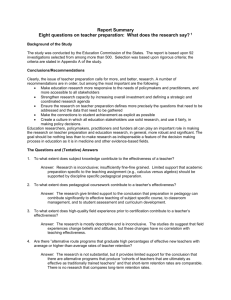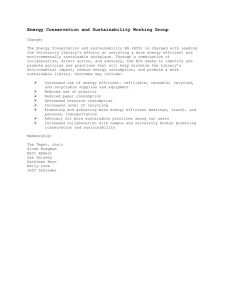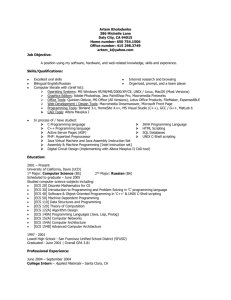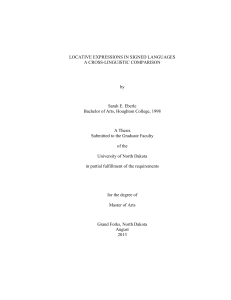Existential Constructions in Flemish Sign Language and Finnish Sign Language
advertisement
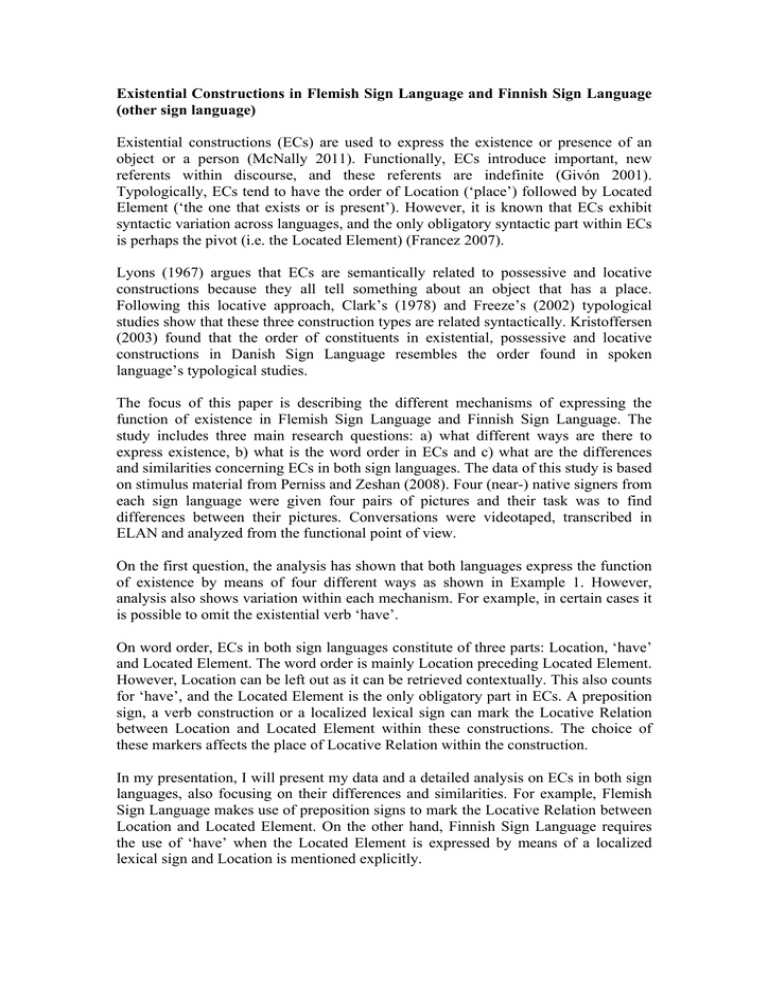
Existential Constructions in Flemish Sign Language and Finnish Sign Language (other sign language) Existential constructions (ECs) are used to express the existence or presence of an object or a person (McNally 2011). Functionally, ECs introduce important, new referents within discourse, and these referents are indefinite (Givón 2001). Typologically, ECs tend to have the order of Location (‘place’) followed by Located Element (‘the one that exists or is present’). However, it is known that ECs exhibit syntactic variation across languages, and the only obligatory syntactic part within ECs is perhaps the pivot (i.e. the Located Element) (Francez 2007). Lyons (1967) argues that ECs are semantically related to possessive and locative constructions because they all tell something about an object that has a place. Following this locative approach, Clark’s (1978) and Freeze’s (2002) typological studies show that these three construction types are related syntactically. Kristoffersen (2003) found that the order of constituents in existential, possessive and locative constructions in Danish Sign Language resembles the order found in spoken language’s typological studies. The focus of this paper is describing the different mechanisms of expressing the function of existence in Flemish Sign Language and Finnish Sign Language. The study includes three main research questions: a) what different ways are there to express existence, b) what is the word order in ECs and c) what are the differences and similarities concerning ECs in both sign languages. The data of this study is based on stimulus material from Perniss and Zeshan (2008). Four (near-) native signers from each sign language were given four pairs of pictures and their task was to find differences between their pictures. Conversations were videotaped, transcribed in ELAN and analyzed from the functional point of view. On the first question, the analysis has shown that both languages express the function of existence by means of four different ways as shown in Example 1. However, analysis also shows variation within each mechanism. For example, in certain cases it is possible to omit the existential verb ‘have’. On word order, ECs in both sign languages constitute of three parts: Location, ‘have’ and Located Element. The word order is mainly Location preceding Located Element. However, Location can be left out as it can be retrieved contextually. This also counts for ‘have’, and the Located Element is the only obligatory part in ECs. A preposition sign, a verb construction or a localized lexical sign can mark the Locative Relation between Location and Located Element within these constructions. The choice of these markers affects the place of Locative Relation within the construction. In my presentation, I will present my data and a detailed analysis on ECs in both sign languages, also focusing on their differences and similarities. For example, Flemish Sign Language makes use of preposition signs to mark the Locative Relation between Location and Located Element. On the other hand, Finnish Sign Language requires the use of ‘have’ when the Located Element is expressed by means of a localized lexical sign and Location is mentioned explicitly. Example 1: different ways of expressing existence i) HEEFT (VGT ‘have’) and OLLA (FinSL ‘have’) Example: OUTSIDE HAVE GRASS GREEN ii) classifier construction Example: COUCH WHITE cl-­‐(spot) iii) localized lexical sign Example: WALL THREE PAN HANG-­‐a HANG-­‐b HANG-­‐c iv) a combination of ‘have’ with a classifier construction or localized lexical sign References: CLARK, EVE V. 1978. Locationals: existential, locative, and possessive constructions. – Joseph H. Greenberg, Charles A. Ferguson, Edith A. Moravcsik (eds.), Universals of Human Language, Vol. 4: Syntax p. 85-­‐126. Stanford: Stanford University Press. FRANCEZ, ITAMAR 2007. Existential Propositions. Ph.D. dissertation. Stanford University, Stanford, CA. FREEZE, RAY 1992. Existentials and other locatives. – Language 68 p. 553-­‐595. GIVÓN, TALMY 2001. Syntax. Volume 1. Amsterdam: John Benjamins. KRISTOFFERSEN, JETTE H. 2003. Existence, Location and Possession and the Order of Constituents in Danish Sign language. – Anne Baker – Beppie van den Bogaerde – Onno Crasborn (eds.), Cross-­‐Linguistic Perspectives in Sign Language Research: Selected Papers from TISLR 2000 p. 131-­‐139. Hamburg: Signum Verlag. LYONS, JOHN 1967. A note on possessive, existential and locative sentences. – Foundations of Language 3 p. 390-­‐396. McNALLY, LOUISE. 2011. Existential sentences. – C. Maienborn, K. von Heusinger & P. Portner, (eds). Semantics: An International Handbook of Natural Language Meaning. Berlin: de Gruyter, 1829-­‐1848. ZESHAN, U. and PERNISS, P. (eds.) 2008. Possessive and existential constructions in sign languages. (Sign Language Typology Series No.2). Nijmegen: Ishara Press.

